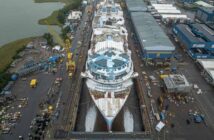
The Westminster Government has declined to offer further financial support to Harland & Wolff, opting for market-based solutions instead.
Trade unions and politicians are call for long-term sustainable future for the Belfast shipyards and express hope for potential buyers to invest in the business.
The loss-making shipbuilder had applied for a loan guarantee of up to £200m which would have allowed the company to borrow money with the government acting as guarantor
Among the proposals to reduce the shipyard is one from Michael Flacks, founder of Flacks Group, who claims he can transform Harland & Wolff into a strategic North Atlantic ship repair business and could acquire the shipyard without relying on bank loans for funding.
H&W last made a profit in 1968, since when the shipyard has been subsidised by the Westminster government. It was estimated by UU lecturer Richard Harrison that H&W losses totalled 35pc of its turnover.
Having once employed 40,000 workers and been the scene of infamous violent pogroms against Catholic workers in 1886, 1912. 1920-21, 1935, 1939, 1943, 1969 and 1970, Harland & Wolff has recently been engaged in repair of oil rigs and worker numbers fell to 400. Two cruise ships were sent to the shipyard for refits recently. It is most famous as the yard in which the Titanic was constructed.
H&W was a privately-owned shipyard established in 1861 known for building innovative ships with flat-bottomed hulls and strong iron upper decks.
Between 1909 and 1914, H&W built the Olympic, Titanic and Britannic ships and also constructed small warships during WWI. The expulsion of the few Catholic workers who found employment in the shipyards was something of a Belfast tradition.
Despite extensive damage to the Queen’s Island facility was damaged during the Belfast Blitz and produced six aircraft carriers by the end of WWII. The Supertakner Myrina was built there in 1968. Before the expulsion of 1935, there were just 200 Catholics out of 4,000 workers. Before another 1970 (the tenth) there were 400 Catholics out of 10,000 workers.
Nationalised in 1977, H&W was later sold to a management/employee buyout in 1989 and diversified into ship refits, oil platform repairs, wind turbines, leading to its parent company going into administration in 2019..
Westminster Business Secretary, Jonathan Reynolds, said in a written statement:”this decision was based on a comprehensive assessment of the company’s financial profile and the criteria set out in our risk policies. We have also decided not to provide any form of emergency liquidity funding. The Government believes, in this instance, that the market is best placed to resolve the commercial matters faced by Harland and Wolff.”



